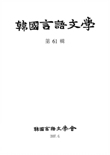- 영문명
- The meaning of Samsaeng in Samsaengokchohwajeon
- 발행기관
- 한국언어문학회
- 저자명
- 민영대(Min Youngdae)
- 간행물 정보
- 『한국언어문학』韓國言語文學 第61輯, 109~135쪽, 전체 27쪽
- 주제분류
- 어문학 > 한국어와문학
- 파일형태
- 발행일자
- 2007.06.30

국문 초록
영문 초록
It seems that traditionally, our people believed that our lives do not end in death and therefore believe in an afterlife. This has a close connection with shamanism and Buddhism.
That kind of belief can be found in countless stories and novels such as Choichiwon(최치원), Dohwanyeobihyungrang(도화녀비형랑), Isaengkyujangjeon(이생규장전), Shimcheongjeon(심청전), Wangrangbanhonjeon(왕랑반혼전), Janghwahongryunjeon(장화홍련전), Joobongjeon(주봉전), etc.
In this work, the heroine dies three times and revives three times. After the mourning ritual of three days for her husband"s death, she killed herself to follow her husband and experience the afterlife. The passionate love for her husband and yearning for her mother makes her choose death, and this is an extreme climax. She revives in reward of this, but because of the avariciousness of the district governor, she kills herself again to remain faithful to her husband. But she is given a second chance to revive for her mortification and grievousness to be resolved. Finally she kills herself for a third time to follow the death of her father-in-law, which is a typical model of a faithful wife and a filial daughter-in-law. She is given a third chance to revive. She is told that her life in this world has not ended and she is ordered by her husband and her mother-in-law to come back to them after leading a more difficult life in this world. This is to guarantee a happy life in compensation for a life in this world dotted with sufferings and hardships.
This work was a result of the dreams and hopes of authors and readers who were desiring and dreaming better life in times of difficulties, and also it was the author"s intention to herald the beautiful life of heroine, a kin of his family. On the other hand, ‘Samsaeng’ has a close connection to the belief of revival and the beliefs of Buddhism our people had.
That kind of belief can be found in countless stories and novels such as Choichiwon(최치원), Dohwanyeobihyungrang(도화녀비형랑), Isaengkyujangjeon(이생규장전), Shimcheongjeon(심청전), Wangrangbanhonjeon(왕랑반혼전), Janghwahongryunjeon(장화홍련전), Joobongjeon(주봉전), etc.
In this work, the heroine dies three times and revives three times. After the mourning ritual of three days for her husband"s death, she killed herself to follow her husband and experience the afterlife. The passionate love for her husband and yearning for her mother makes her choose death, and this is an extreme climax. She revives in reward of this, but because of the avariciousness of the district governor, she kills herself again to remain faithful to her husband. But she is given a second chance to revive for her mortification and grievousness to be resolved. Finally she kills herself for a third time to follow the death of her father-in-law, which is a typical model of a faithful wife and a filial daughter-in-law. She is given a third chance to revive. She is told that her life in this world has not ended and she is ordered by her husband and her mother-in-law to come back to them after leading a more difficult life in this world. This is to guarantee a happy life in compensation for a life in this world dotted with sufferings and hardships.
This work was a result of the dreams and hopes of authors and readers who were desiring and dreaming better life in times of difficulties, and also it was the author"s intention to herald the beautiful life of heroine, a kin of his family. On the other hand, ‘Samsaeng’ has a close connection to the belief of revival and the beliefs of Buddhism our people had.
목차
1. 머리말
2. 작품의 서사단락과 여주인공의 三生
3. 三生과 유관한 선행 작품
4. 본 작품에서 三生의 의미
5. 마무리
〈참고문헌〉
[Abstract]
2. 작품의 서사단락과 여주인공의 三生
3. 三生과 유관한 선행 작품
4. 본 작품에서 三生의 의미
5. 마무리
〈참고문헌〉
[Abstract]
키워드
해당간행물 수록 논문
참고문헌
최근 이용한 논문
교보eBook 첫 방문을 환영 합니다!

신규가입 혜택 지급이 완료 되었습니다.
바로 사용 가능한 교보e캐시 1,000원 (유효기간 7일)
지금 바로 교보eBook의 다양한 콘텐츠를 이용해 보세요!



